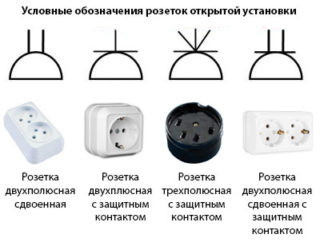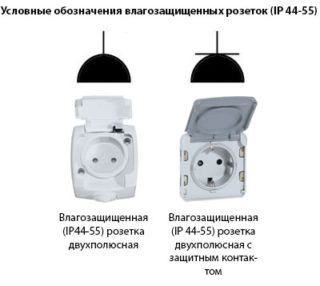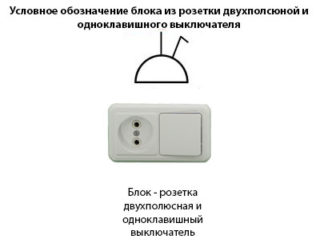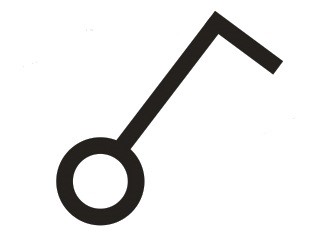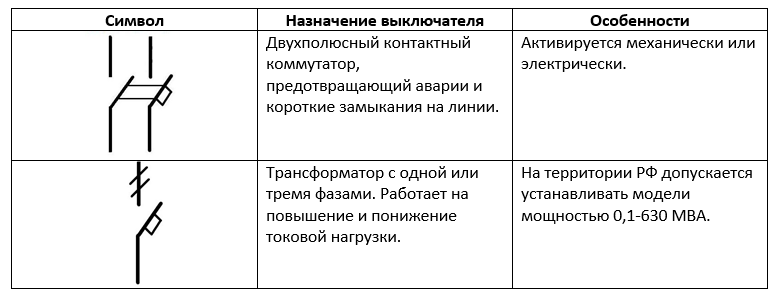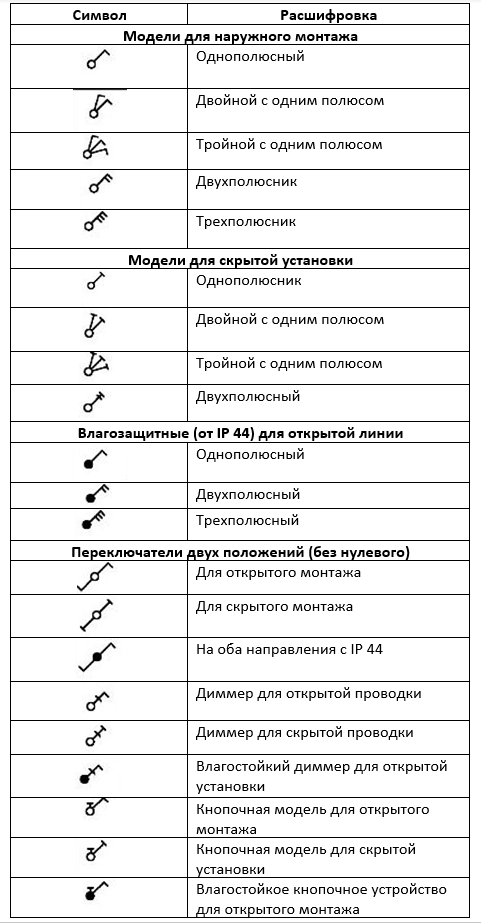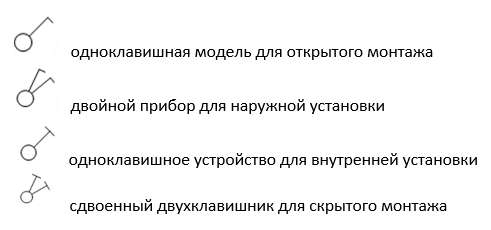Before arranging a home electrical network, you need to draw up a drawing with the main nodes - an input line, a meter, an RCD, distribution boxes, and a lighting system. The designation of the outlet on the power supply diagram is regulated by law. The device according to GOST is marked with a semicircle, from the convex side of which there are dashes like a switch.
- The need for a scheme
- Normative base
- Specificity of designations in Russian GOSTs
- Types of electrical circuits adopted in domestic practice
- Functional and structural diagram
- Basic wiring diagram
- Installation drawing
- Specificity of the designation of the socket in the diagram
- Symbols of sockets for outdoor / outdoor installation
- Flush-mounted / flush-mounted socket designations
- Marking of moisture-resistant sockets (degree of protection of the case IP44-IP55)
- How are the blocks from the switch and the socket indicated
- Specificity of circuit breaker symbols
- Marking of one-key and two-key models on wiring diagrams
- Symbols for other devices
The need for a scheme
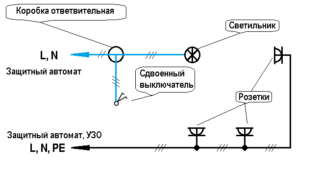
For the purpose of high-quality and safe placement of electrical wiring, a plan is drawn up. It looks like a drawing with a scale. The document reflects the layout of the apartment, the points of placement of wiring nodes by groups, as well as schematic diagrams.
To understand the drawing by all participants in the repair and installation work, the sockets and switches are indicated by graphic drawings according to the all-Russian and global standards.
Geometric shapes - circles, squares, rectangles, points and lines are used as graphic markers. Their combinations reflect the types of mechanisms of the lighting system and the control features of these devices.
Normative base
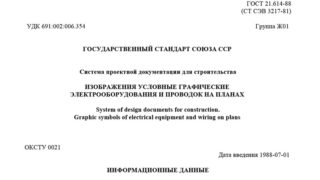
On the territory of the Russian Federation, the designation of a group or single sockets and switches on design drawings is subject to the following documents:
- GOST 21.614-88. Subsection "Conditional graphic images of electrical equipment and wiring" from the section on the system of design and construction documentation;
- GOST 21.210-2014. Electrical devices, according to the standard, can be depicted in the form of standard symbols;
- IEC 60027. The standard adopted by the International Electrotechnical Commission, according to which the wiring in Russian buildings must comply with international requirements.
In the regulatory documentation, the specifics of creating conditional power line icons and auxiliary devices on the working diagram are noted.
Specificity of designations in Russian GOSTs
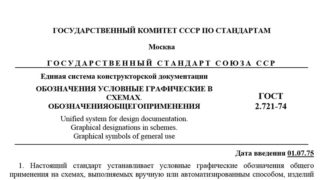
The domestic regulatory framework, indicating which rules and methods the marking of parts of the electrical circuit is subject to, includes the following GOSTs:
- 2.755-87 - the section on conventional icons for contacts and switching connections defines the way to designate a thermal relay, contactors, circuit breakers, circuit breakers. There is no graphic index for RCDs and difavtomats;
- 2. 721-74 - indicates which sign is used for common parts and assemblies and secondary power grids;
- 2. 709-89 - the features of the graphic marking of the sections of the electrical circuit, special equipment, cable connection technologies and other elements are noted.
GOST 2.702-2011 specifies the possibility of an arbitrary image of nodes and the need to decipher markers.
Types of electrical circuits adopted in domestic practice
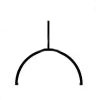
According to the requirements of ESKD, the diagram is a graphic document where the structural parts of the system and the technologies for their connection are marked with special icons. According to the accepted international classification, there are more than 10 of them. Not all of them are used on the territory of the Russian Federation.
Functional and structural diagram
Structural - the simplest diagram in which the image of the circuit elements is made in squares with explanations. This technique helps to understand the features of the system. The functional drawing contains a detailed description of the nodes, their electrical connections.
Basic wiring diagram
It is used for arranging distribution lines and control panels. Elements without relative position are inscribed on it. The basic drawing is:
- single-line with power circuits - one common line is used for ground, phase and zero;
- complete with all nodes and veins of their connection - electrical communications are drawn in expanded and element-wise form.
A complete schematic diagram is drawn up on several sheets.
Installation drawing
Contains a plan for the placement of lighting devices, sockets and switches with an indication of the connection method. May contain additional information required for electrical work.
If it is necessary to save space on the sheet and knowledge of marking without signatures, a unified scheme is used. It combines the above types of drawings.
Specificity of the designation of the socket in the diagram
Electrical accessories are classified according to the degree of protection, installation method, and the number of poles. These parameters explain the differences in the symbols in the drawing.
Symbols of sockets for outdoor / outdoor installation
The following designations are indicated on the diagram of the fittings selected for the outdoor installation method:
- pairing, grounding and unipolarity;
- pairing, absence of "ground" and unipolarity;
- unary, one pole and the presence of a protection contact;
- a power outlet that has 3 poles and protection.
The single pole double socket is shaped like a semicircle with a dash in the center. The bipolar one has two dashes. Two-pole, earthed, surface-mounted models are identified as a semicircle with a horizontal line extending on either side and a vertical bar. Three-pole devices with "ground" - a semicircle with 5 fan lines (1 in the center and 4 on the sides). Single devices are marked with one line, double ones - with a double dash.
Under the three-phase type of network, three-pole switches are suitable, designated as a semicircle with three outer dashes.
Flush-mounted / flush-mounted socket designations
The socket intended for hidden wiring is indicated on the diagram in the form of a semicircle crossed along a vertical line.
Modifications are installed internally:
- bipolar - a semicircle with a central vertical line extending beyond the contour of the figure;
- bipolar with protective contact - a semicircle with a vertical line directed upwards and a horizontal line protruding beyond it;
- three-pole with a protective contact - a semicircle with a dash in the center and black lines (5 pieces on top);
- bipolar double - a semicircle with a dash in the center and two bold parallel lines (resembles a plug).
The horizontal ground line is the same for all models.
Marking of moisture-resistant sockets (degree of protection of the case IP44-IP55)
- waterproof with two poles - a black semicircle with a dash on top;
- waterproof with two poles and a protective contour - a black semicircle with a horizontal line and a line at the top.
Marking the degree of protection in English letters IP indicates its presence.The first number means the level of dust protection, the second - moisture protection.
How are the blocks from the switch and the socket indicated
- Flush-mounted box (1 switch + 1 socket) - a semicircle with a vertical line protruding upwards. A T-shaped diagonal line extends from its bottom.
- Flush-mounted block (1 switch + 1 socket with grounding) - a semicircle with vertical and horizontal lines (form a cross). From the bottom point of the figure there is a diagonal line in the form of a T;
- hidden double switch block and earthed socket - a semicircle with a vertical and horizontal cross-shaped line. From the common point to the left and to the right, T-shaped lines emerge diagonally;
- a block in which there is a two-key and one-key switch, as well as a socket - a semicircle with vertical and horizontal dashes forming a cross. On the left, a T-shaped diagonal line emerges from the common point. On the right is a line with a diagonal direction and two short horizontal lines "covering" it.
Due to the complexity of block diagrams, it is better to indicate footnotes.
Specificity of circuit breaker symbols
The generally accepted designation of the switch on the power circuit diagram is as follows:
GOST 21.210-2014 states that there is no single icon for push-button models and dimmers. In clause 4.7. the document says that you can take arbitrary values.
Sometimes drawings indicate an automatic switch type. Its symbol can be seen from the table.
The graphic symbols used to designate the switch are indicated in the form of a table.
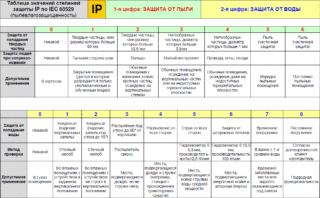
GOST 21.614-88 contains recommendations on conventional icons for switch groups:
- for surface mounting (protection from IP20 to IP23);
- for hidden wiring (protection from IP20 to IP23);
- moisture resistant devices (protection from IP44 to IP55);
- two-position pass-through device with protection from IP20 to IP23;
- moisture resistant pass-through models with protection from IP44 to IP55.
GOST R-52565-2006 notes that the pole of one switch must close only one line.
Marking of one-key and two-key models on wiring diagrams
To designate the switch, you must specify the number of keys. For this purpose, the symbols are used:
Three-key devices are designated as a dash with a circle and three hooks.
Symbols for other devices
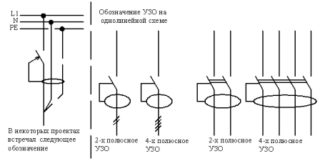
In addition to switches and sockets, the wiring diagram contains other components. For example, a circuit breaker, an RCD, a voltage control relay are indicated as an open contact.
According to GOST, a certain number of contacts connected to each other and a square on the side are used for marking a circuit breaker. The image indicates the simultaneous actuation and the presence of protection. At the entrance, the apartment is equipped with a two-pole automatic device, single-pole ones are used to stop the load.
Difautomatics and RCDs do not have the icons regulated by GOST, therefore, the design specifics are depicted in the drawings. RCD devices are current transformers with an executive contact relay. The differential automaton has a similar assembly, but an automaton has been added to the nodes that protects against short circuits and overload.
The controller relay is designed to turn off the equipment in case of exceeding the voltage rating. It is a board and a contact relay. The circuit is applied to the cover of the device and transferred to the power line plan.
Several graphic symbols are used for lighting and lighting devices:
- square - luminescent light source 600x600 mm;
- rectangle - fluorescent lamp 600x300 mm;
- square with two lines - 600x600 mm LED light source;
- a large "bow" with partially filled black triangles - an emergency lighting device 600x600 mm;
- a narrow "bow" with partially filled black areas on the triangles - a device for emergency lighting 600x300;
- a circle divided by an arc - a device with a high pressure lamp;
- a circle without two segments with 4 dashes ("slices") and a horizontal arrow to the right - a spotlight;
- a circle divided in half - a light source with contact lamps of the fluorescent type;
- circle with narrow areas at the top and bottom - LED luminaire of any non-linear shape;
- circle - a lamp with a halogen or incandescent lamp;
- a circle divided into 6 segments - a chandelier;
- rectangle - linear fluorescent lamp;
- rectangle with 2 dashes - linear LED luminaire;
- black bow - emergency lamp.
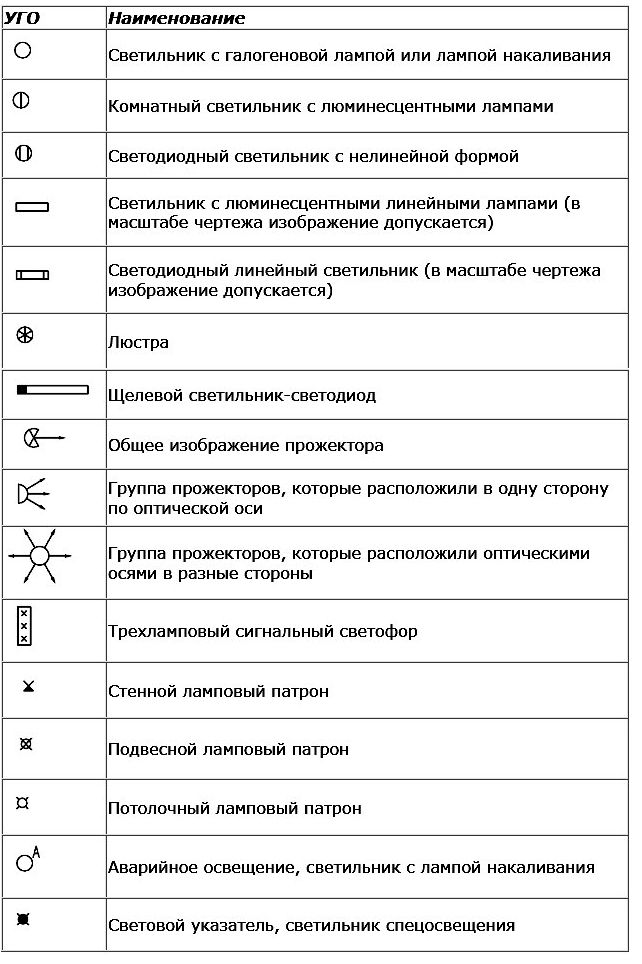
The device icon is selected depending on their appearance and purpose.
It is not necessary to know the symbols of parts of the electrical network by heart. With an understanding of the icons and a correctly drawn drawing, the user will always decipher the symbols or read the footnotes.

